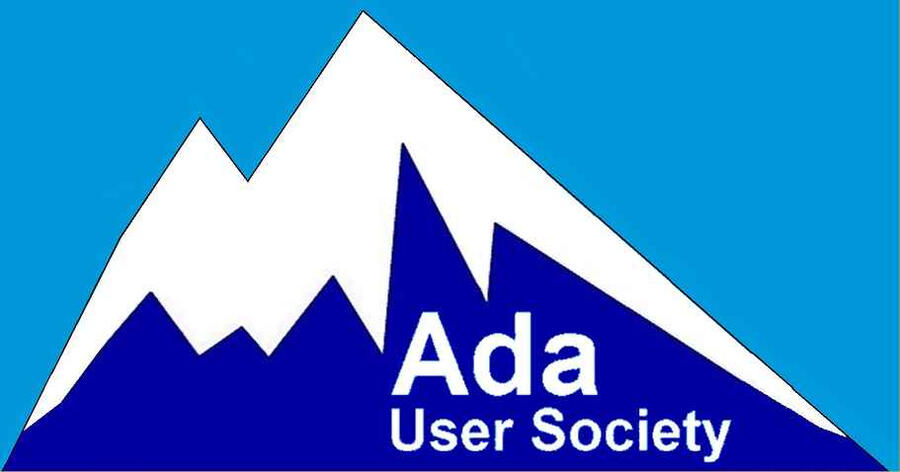Ensuring communitarian care for Ada: the mission of the Ada User Society
Scientific knowledge suggests that “languages originate from social needs”. Social needs form in the presence of stable social gatherings. Some by necessity; others by election. Social needs are intrinsically and eminently communitarian. Languages that reflect social needs cause users to hold shared responsibility for how their language should evolve and how it should represent their take in it.
By extension, it can be said that also programming languages reflect some specific sort of “social needs”; thus, at some level, the “ideology”, a view of the world, of how a program tells what is (wanted) to happen and, by virtue of its compiler, hence its grammar, how it abides to that intent at run time.
These tenets are especially (though not exclusively) true of Ada. It is therefore consequent that Ada can be seen as the expression of the social needs – within the precincts of programming – of its constituency.
In the social gathering of a programming language there are diverse roles and different levels of responsibility, but there also is one single common allegiance.
- There are language designers, who turn user needs into language features.
- There are language lawyers, who turn design features into language specifications.
- There are language implementors, who turn specifications into usable technology.
- And then there are language users, language educators, language evangelists, language historians.
All individuals in these roles constitute a single community.
Of course, a critical value chain extends across some of the above roles, whose monetary worth allows rewarding part of the work required for the language to continue to exist.
The monetary element of the value chain, however, should never reduce the ecology of a language community to the bilateral relation between customers and suppliers. Arguably, there is more to a programming language than paying customers and technology providers, and it is so because of the communitarian nature of language.
There are moments in the life of programming languages where very little is required of some members of the language community, as almost all that seems to import happens via paid roles and tasks. There are other times, however, in which the economic sustainability of those paid roles and tasks is threatened. It is at those times especially that the entire community, regardless of the assigned roles in it, is urged to become more directly responsible for the continued existence of the language.
This is one such moment for Ada: this understanding has prompted the birth of the Ada User Society.
From its initial launch in April 1983 until the end of the “Ada Mandate” (March 1997), the Ada language specification was a standard under four agencies: three of them were strictly US-based: ANSI, DoD, and NIST; the fourth was ISO, which is global and international.
With the cessation of the Ada Mandate, and the release of “Ada 95”, the outcome of the “Ada 9X Project” (run between October 1988 and April 1993), ISO became the “home” of the Ada standard.
Under ISO, the Ada standard specification was placed under:
- Joint Technical Committee 1 on Information Technology (ISO/IEC JTC 1)
- Standards Committee 22 (SC 22)
- Working Group 9 (WG 9).
WG 9 has one representative per (participating) country, nominated via their national standards organization, and an internal group, named Ada Rapporteur Group, ARG, tasked to do the technical work entailed by the corrective, adaptive and evolutive maintenance of the language, which of course requires a reference implementation.
Retaining conformance with ISO procedures carries considerable costs, especially service time and other admin overheads of WG 9 and ARG operation.
Progressively since 1997, the sustenance of those costs had been shouldered by a single commercial vendor, with very little direct support from any other entity, including Ada associations. When a single, private, entity comes to bear all the costs of keeping a social benefit alive, then the question of language ownership arises, and the prospect of “privatizing” becomes a natural option. If that came to pass, however, Ada would cease to be the language of a “social gathering” and therefore derail its nature and its mission.
ISO rules require periodic renewals or confirmation of its officials and of the associated membership, as well periodic plans for revisions of the standard specification. September 2025 was the time where such steps had to be taken. That horizon prompted the global Ada community to pull itself together and take direct and collective action for the continuation of Ada as an international standard, under a communitarian process, sharing as much of the load and responsibility as possible.
Facilitating, overseeing and securing that process was and is the mission of the Ada User Society. Accomplishing those objectives requires:
- Membership to the Ada User Society from anybody anywhere, who feels that Ada continues to have value in the programming language landscape.
- Voluntary contribution to the technical work entailed by the maintenance of the language specifications, including reference implementations, libraries, utilities and example applications, and any other implementation contributions that amplify the language ecosystem.
- Financial donations to help sustain the costs that necessarily arise in keeping conformance with the ISO process, and to promote and reward implementation contributions.
The Ada User Society was founded on 11 April 2024 with this specific mission. Carrying it out requires your help: please, consider joining!
This text is an adaptation of the short article “It is Time to Care for Ada!”, which appeared in Issue 4, Volume 45 of the Ada User Journal, a periodical of Ada-Europe.
See the companion presentation.
